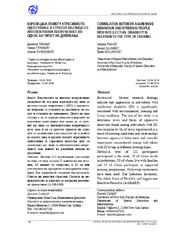Приказ основних података о документу
Correlation between aggressive behaviour and stress in people with intellectual disability in relation to the type of housing
| dc.creator | Tamaš, Daniela | |
| dc.creator | Glumbić, Nenad | |
| dc.creator | Golubović, Špela | |
| dc.date.accessioned | 2021-06-09T14:15:44Z | |
| dc.date.available | 2021-06-09T14:15:44Z | |
| dc.date.issued | 2016 | |
| dc.identifier.issn | 1409-6099 | |
| dc.identifier.uri | http://rfasper.fasper.bg.ac.rs/handle/123456789/1015 | |
| dc.description.abstract | Backround: Several research findings indicate that aggression in individuals with intellectual disability (ID) is significantly associated with environmental, housing and living conditions. The aim of this study is to determine levels and forms of aggressive behaviour found among individuals with ID; also examine levels of stress experienced as a result of housing conditions and relationships between aggressive behaviours and stressful experiences encountered among individuals with ID living in different housing types. Method: A total of 122 participants participated in the study, 51 of whom reside in institutions, 38 of whom live with families and 33 of whom participate in supported housing programmes. Following instruments have been used: The Lifestress Inventory, The Adult Scale of Hostility and Aggression Reactive-Proactive (A-SHARP). Results: The results reveal that there is a connection between housing types and levels and forms of aggressive behaviour and the level of stress experienced by the individuals with ID. Aggressive behaviour is least pronounced among the participants living in supported housing programmes (verbal aggression: p=0.001; bullying: p=0.002; covert aggression; p=0.003; hostility affect: p=0.002 and physical aggression: p=0.001). Among the participants living in institutions and with families is no statistically significant difference in terms of the level of any form of aggressive behaviour. Participants from supported housing programmes showed significantly lower levels of stress in comparison to the other two sub-samples (p=0.000). Conclusions: There is a statistically significant correlation between aggressive behaviour among individuals with ID and experienced stress, depending on the type of the participants housing. | en |
| dc.publisher | Institute of Special Education and Rehablitation | |
| dc.rights | openAccess | |
| dc.rights.uri | https://creativecommons.org/licenses/by/4.0/ | |
| dc.source | Journal of Special Education and Rehabilitation | |
| dc.subject | Aggression | en |
| dc.subject | Intellectual disability | en |
| dc.subject | Stress | en |
| dc.subject | Supported housing | en |
| dc.title | Correlation between aggressive behaviour and stress in people with intellectual disability in relation to the type of housing | en |
| dc.type | article | |
| dc.rights.license | BY | |
| dc.citation.epage | 61 | |
| dc.citation.issue | 3-4 | |
| dc.citation.other | 17(3-4): 46-61 | |
| dc.citation.rank | M51 | |
| dc.citation.spage | 46 | |
| dc.citation.volume | 17 | |
| dc.identifier.doi | 10.19057/jser.2016.9 | |
| dc.identifier.fulltext | http://rfasper.fasper.bg.ac.rs/bitstream/id/13/1012.pdf | |
| dc.identifier.scopus | 2-s2.0-84996489745 | |
| dc.type.version | publishedVersion |


